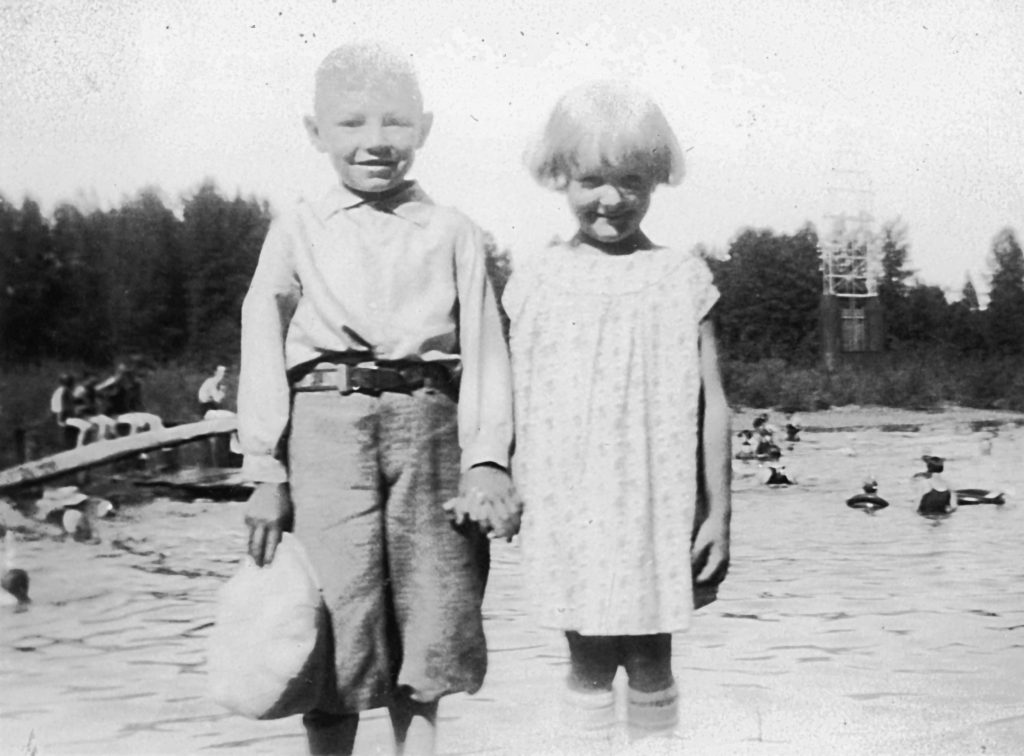Mom didn’t put a caption on this photo. I don’t know whether she overlooked it or just didn’t remember who was in it when she was adding captions.

It’s an adorable photo of this boy and girl, whoever they are. It seems almost like I should recognize them, but I haven’t been able to come up with anything. If you recognize them, or even have a guess, please speak up. The photo cannot have been taken before 1926 (more on that below), so the boy and girl would have been born in the early 1920s (or maybe the very end of the 1910s, if you want to push it). Does that give a hint?
Even though I have no identification for the children (or anyone else in the photo), I do know where it was taken. (And if you are familiar with Albany, you probably know, too.) The key to both the location and the date of this photo is across the water on the right side of it: the electrical transmission tower built on a former bridge pier. (Click/tap the image above to get the enlarged version so you can zoom in and take a look.)
Here’s the background: In 1893 a new bridge was built across the Willamette River at Albany. It was the first non-railroad bridge across the river there. On the Albany side, the bridge went above what is now Monteith Park. It was a spindly, rickety one-lane bridge (though probably typical of bridges of that era). It was made of steel, but it looked like you could just blow it over. The bridge was so fragile that this sign was placed above the end of the bridge on the Albany side. I assume there was a similar sign on the North Albany side of the bridge, but I’ve never seen a photo of it.

In case you can’t quite make it out…
NOTICE! **100.00 FINE
for any person or persons riding or driving faster than a walk, or for driving more than 20 head of horses, cattle or mules, or 100 head of sheep at any one time or driving any stock faster than a walk over this bridge.
My question is: what would you do with the 100 head of sheep once you drove them across the bridge into downtown Albany, even if you did so at the required pace? ;–)
But I’m getting off track. A new, two-lane bridge designed by Conde McCullough was finished in 1926. This is the Ellsworth Street bridge that still carries traffic over the river today. When that bridge was put into service, the old bridge was demolished. All except the piers that supported it. The piers were repurposed to support electrical transmission towers like the one you see in today’s photo.
From this we know that the photo could not have been taken before 1926, because a bridge would have been there still. I wasn’t able to find out when the transmission towers were first built on the bridge piers. Possibly that information would push the earliest possible date for this photo into 1927. I went with 1927 as an approximate date for that reason.
The bridge pier you see on the right side of today’s photo is on the North Albany side of the river. So the children are standing on the Albany side, west of the old bridge (west of Monteith Park today). The swimmers in the river provide an additional clue to location. At that spot the Calapooia River runs into the Willamette, and Bryant Park is on the west bank of the Calapooia there. That area had been a popular swimming hole for years (perhaps decades) before this photo was taken.
The City of Albany web site has several historic photos of swimming at Bryant Park and of the old bridge.
OK, so the children are standing on the riverbank at or near the confluence of the Calapooia and Willamette Rivers not earlier than 1926 and probably more like 1927. What does any of this have to do with family history, beyond the fact that the above photo is in Mom’s album? I guess it’s about the location, and about the way our family history is interwoven with the history of Albany, and has been since 1890 when the Hammells first stepped off the train there (even before the old bridge was built). It is the location of today’s photo, and the history of the location that is significant to family history, even if we never find out who the boy and girl are.
That said, it would be interesting to know who they are.